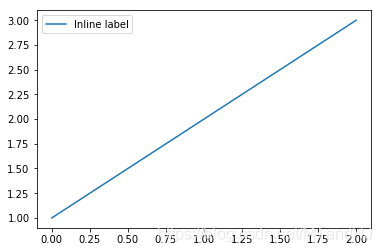matplotlib 进阶之Legend guide
import numpy as np
import matplotlib.pyplot as plt
matplotlib.pyplot.legend
在开始教程之前,我们必须先了解matplotlib.pyplot.legend(),该函数可以用以添加图例。
方法1自动检测
通过这种方式,lendgend()会从artist中获取label属性,并自动生成图例,比如:
fig, ax = plt.subplots()
line, = ax.plot([1, 2, 3], label="Inline label")
ax.legend()
plt.show()
或者:
line.set_label("Inline label")
ax.legend()

方法2为现有的Artist添加
我们也可以通过下列操作,为已经存在的Artist添加图例,但是这种方式并不推荐,因为我们很容易混淆。
fig, ax = plt.subplots()
line, = ax.plot([1, 2, 3])
ax.legend(["A simple line"])

方3显示添加图例
我们也可以显示添加图例:
fig, ax = plt.subplots()
line1, = ax.plot([1, 2, 3])
line2, = ax.plot([3, 2, 1])
ax.legend((line1, line2), ("line1", "line2"))

参数:
handle: Artist
label: 标签
loc:位置,比如"best":0, "upper right" 1 ...
fontsize
...
控制图例的输入
直接使用legend()命令,matplotlib会自动检测并生成图例,这种方式等价于:
handles, labels = ax.get_legend_handles_labels()
ax.legend(handles, labels)
需要注意的是,只有为Artist设置标签了,通过get_legend_handles_labels()才有效。
有些时候,我们只需要为部分Artist设置图例,这时只需手动传入handles:
line_up, = plt.plot([1,2,3], label='Line 2')
line_down, = plt.plot([3,2,1], label='Line 1')
plt.legend(handles=[line_up, line_down])
当然了,相应的可以传入标签:
line_up, = plt.plot([1,2,3], label='Line 2')
line_down, = plt.plot([3,2,1], label='Line 1')
plt.legend([line_up, line_down], ['Line Up', 'Line Down'])
为一类Artist设置图例
并不是所有的Artist都能被自动设置为图例,也不是所有Artist都需要被设置为图例。
假如我们想要为所有红颜色的玩意儿设置图例:
import matplotlib.patches as mpatches
x = np.arange(1, 4)
fig, ax = plt.subplots()
for i in range(1, 10):
ax.plot(x, i * x, color = "red" if i % 2 else "blue")
red_patch = mpatches.Patch(color="red")
# red_patch: <matplotlib.patches.Patch object at 0x00000228D0D4BF60>
plt.legend(handles=[red_patch], labels=["red line"])
plt.show()
如果没理解错,通过patches.Patch构造了一个颜色为红色的Artist类,然后legend()就会对所有满足条件的Artist的类进行处理(其实也用不了处理啊,只是加了图例)。错啦错啦,实际上,就是简单地造了一个颜色为红色的片,价格red line标签而已,跟已有的Artist没啥关系。

实际上,图例并不十分依赖于现有的Artist,我们完全可以随心所欲地添加:
import matplotlib.lines as mlines
blue_line = mlines.Line2D([], [], color='blue', marker='*',
markersize=15, label='Blue stars')
plt.legend(handles=[blue_line])
plt.show()

Legend 的位置 loc, bbox_to_anchor
legend()提供了loc参数,可以处理一般的位置。而bbox_to_anchor参数可以更加有效强大地来定位:
x = np.arange(1, 4)
fig, ax = plt.subplots()
for i in range(1, 10):
ax.plot(x, i * x, color = "red" if i % 2 else "blue", label="line{0}".format(i))
plt.legend(bbox_to_anchor=(1, 1),
bbox_transform=plt.gcf().transFigure)
plt.show()

bbox_to_anchor=(1,1)表示legend的位置在右上角,因为bbox_transform,我们将坐标转换为了当前figure的坐标系,也就是图例会放在整个图片的右上角,如果我们去掉这个选项:
plt.legend(bbox_to_anchor=(1, 1))

这个时候和下面是等价的:
plt.legend(bbox_to_anchor=(1,1),
bbox_transform=ax.transAxes)
即,此时的(1,1)表示的是Axes的右上角。
当我们这么做的时候:
plt.legend(bbox_to_anchor=(1, 1),
bbox_transform=ax.transData)
这个时候以数据,也就是我们看到的坐标为依据:

一个具体的例子
下面会用到的一些参数分析:
bbox_to_anchor: (x, y, width, height) 说实话,我并没有搞懂width, height的含义,有的时候能调正宽度,有的时候又不能
ncol: 图例的列数,有些时候图例太多,让他分成俩列三列啊
boderraxespad: axes与图例边界的距离。
plt.subplot(211)
plt.plot([1, 2, 3], label="test1")
plt.plot([3, 2, 1], label="test2")
# Place a legend above this subplot, expanding itself to
# fully use the given bounding box.
plt.legend(bbox_to_anchor=(0., 1.02, 1., .102), loc='lower left',
ncol=2, mode="expand", borderaxespad=0.)
plt.subplot(223)
plt.plot([1, 2, 3], label="test1")
plt.plot([3, 2, 1], label="test2")
# Place a legend to the right of this smaller subplot.
plt.legend(bbox_to_anchor=(1.05, 1), loc='upper left', borderaxespad=1.)
plt.show()

同一个Axes多个legend
如果我们多次使用legend(),实际上并不会生成多个图例:
fig, ax = plt.subplots()
line1, = ax.plot([1, 2, 3])
line2, = ax.plot([3, 2, 1])
ax.legend([line1], ["line1"])
ax.legend([line2], ["line2"])
plt.show()

为此,我们需要手动添加图例:
fig, ax = plt.subplots()
line1, = ax.plot([1, 2, 3])
line2, = ax.plot([3, 2, 1])
legend1 = ax.legend([line1], ["line1"], loc="upper right")
ax.add_artist(legend1)
ax.legend([line2], ["line2"])
plt.show()

Legend Handlers
没看懂啥意思。
from matplotlib.legend_handler import HandlerLine2D
line1, = plt.plot([3, 2, 1], marker='o', label='Line 1')
line2, = plt.plot([1, 2, 3], marker='o', label='Line 2')
plt.legend(handler_map={line1: HandlerLine2D(numpoints=4)})

from numpy.random import randn
z = randn(10)
red_dot, = plt.plot(z, "ro", markersize=15)
# Put a white cross over some of the data.
white_cross, = plt.plot(z[:5], "w+", markeredgewidth=3, markersize=15)
plt.legend([red_dot, (red_dot, white_cross)], ["Attr A", "Attr A+B"])

从这例子中感觉,就是legend_handler里面有一些现成,稀奇古怪的图例供我们使用?
from matplotlib.legend_handler import HandlerLine2D, HandlerTuple
p1, = plt.plot([1, 2.5, 3], 'r-d')
p2, = plt.plot([3, 2, 1], 'k-o')
l = plt.legend([(p1, p2)], ['Two keys'], numpoints=1,
handler_map={tuple: HandlerTuple(ndivide=None)})

自定义图例处理程序
这一节呢,主要就是告诉我们,如何通过handler_map这个参数,传入一个映射,可以构造任意?奇形怪状的图例?不过参数也忒多了吧,不过感觉蛮有用的。
import matplotlib.patches as mpatches
class AnyObject(object):
pass
class AnyObjectHandler(object):
def legend_artist(self, legend, orig_handle, fontsize, handlebox):
x0, y0 = handlebox.xdescent, handlebox.ydescent
width, height = handlebox.width, handlebox.height
patch = mpatches.Rectangle([x0, y0], width, height, facecolor='red',
edgecolor='black', hatch='xx', lw=3,
transform=handlebox.get_transform())
handlebox.add_artist(patch)
return patch
plt.legend([AnyObject()], ['My first handler'],
handler_map={AnyObject: AnyObjectHandler()})

from matplotlib.legend_handler import HandlerPatch
class HandlerEllipse(HandlerPatch):
def create_artists(self, legend, orig_handle,
xdescent, ydescent, width, height, fontsize, trans):
center = 0.5 * width - 0.5 * xdescent, 0.5 * height - 0.5 * ydescent
p = mpatches.Ellipse(xy=center, width=width + xdescent,
height=height + ydescent)
self.update_prop(p, orig_handle, legend)
p.set_transform(trans)
return [p]
c = mpatches.Circle((0.5, 0.5), 0.25, facecolor="green",
edgecolor="red", linewidth=3)
plt.gca().add_patch(c)
plt.legend([c], ["An ellipse, not a rectangle"],
handler_map={mpatches.Circle: HandlerEllipse()})

"""都是啥和啥啊。。。"""
class AnyObject(object):
pass
class AnyObjectHandler(object):
def legend_artist(self, legend, orig_handle, fontsize, handlebox):
x0, y0 = handlebox.xdescent, handlebox.ydescent
width, height = handlebox.width, handlebox.height
patch = mlines.Line2D([1, 2, 3, 4, 6], [1, 2, 3, 4, 6], linewidth=width/2, color='red',
transform=handlebox.get_transform())
handlebox.add_artist(patch)
return patch
plt.legend([AnyObject()], ['My first handler'],
handler_map={AnyObject: AnyObjectHandler()})

函数链接
plt.lengend()-添加图例
get_legend_handles_labels()-获取图例处理对象和对应的标签
matplotlib.patches-包括向量,圆,矩形,多边形等等
legend_artist
matplotlib 进阶之Legend guide的更多相关文章
- matplotlib中的legend()—显示图例
源自 matplotlib中的legend()——用于显示图例 -- 博客园 http://www.cnblogs.com/yinheyi/p/6792120.html legend()的一个用法: ...
- matplotlib 进阶之Tight Layout guide
目录 简单的例子 Use with GridSpec Legend and Annotations Use with AxesGrid1 Colorbar 函数链接 matplotlib教程学习笔记 ...
- matplotlib 进阶之Constrained Layout Guide
目录 简单的例子 Colorbars Suptitle Legends Padding and Spacing spacing with colobars rcParams Use with Grid ...
- matplotlib 入门之Usage Guide
文章目录 Usage Guide plotting函数的输入 matplotlib, pyplot, pylab, 三者的联系 Coding style Backends 后端 matplotlib教 ...
- 【Python学习笔记】调整matplotlib的图例legend的位置
有时默认的图例位置不符合我们的需要,那么我们可以使用下面的代码对legend位置进行调整. plt.legend(loc='String or Number', bbox_to_anchor=(num ...
- 【转】matplotlib制图——图例legend
转自:https://www.cnblogs.com/alimin1987/p/8047833.html import matplotlib.pyplot as pltimport numpy as ...
- matplotlib中的legend()——用于显示图例
legend()的一个用法: 当我们有多个 axes时,我们如何把它们的图例放在一起呢?? 我们可以这么做: import matplotlib.pyplot as plt import numpy ...
- 【python】matplotlib进阶
参考文章:https://liam0205.me/2014/09/11/matplotlib-tutorial-zh-cn/ 几个重要对象:图像.子图.坐标轴.记号 figure:图像, subplo ...
- matplotlib 进阶之origin and extent in imshow
目录 显示的extent Explicit extent and axes limits matplotlib教程学习笔记 import numpy as np import matplotlib.p ...
随机推荐
- day20 系统优化
day20 系统优化 yum源的优化 yum源的优化: 自建yum仓库 使用一个较为稳定的仓库 # 安装华为的Base源 或者使用清华的源也可以 wget -O /etc/yum.repos.d/Ce ...
- 零基础学习java------31---------共享单车案例,html快速入门(常见标签,get和post的区别)
一 .单车案例 二. HTML快速入门 红字表示要掌握的内容 超文本标记语言,此处的标记指的即是关键字,其用处是用来写页面(展示数据). 语法:(1)./当前目录:../ 父级目录 (2)注释符号: ...
- C语言编辑链接
库函数(Library Files)库函数就是函数的仓库,它们都经过编译,重用性不错.通常,库函数相互合作,来完成特定的任务.比如操控屏幕的库函数(cursers和ncursers库函数),数据库读取 ...
- linux下把一个用户从某个组中删除,而不删除用户
查看当前用户/登录用户 基本语法 whoami / who am I 用户组 介绍 类似于角色,系统可以对有共性的多个用户进行统一的管理. 新增组 语法 groupadd 组名 案例演示 添加test ...
- 【力扣】82. 删除排序链表中的重复元素 II
存在一个按升序排列的链表,给你这个链表的头节点 head ,请你删除链表中所有存在数字重复情况的节点,只保留原始链表中 没有重复出现 的数字. 返回同样按升序排列的结果链表. 示例 1: 输入:hea ...
- 莫烦python教程学习笔记——总结篇
一.机器学习算法分类: 监督学习:提供数据和数据分类标签.--分类.回归 非监督学习:只提供数据,不提供标签. 半监督学习 强化学习:尝试各种手段,自己去适应环境和规则.总结经验利用反馈,不断提高算法 ...
- 【简】题解 P5283 [十二省联考2019]异或粽子
传送门:P5283 [十二省联考2019]异或粽子 题目大意: 给一个长度为n的数列,找到异或和为前k大的区间,并求出这些区间的异或和的代数和. QWQ: 考试时想到了前缀异或 想到了对每个数按二进制 ...
- 声临其境,轻松几步教你把音频变成3D环绕音
在音乐创作.音视频剪辑和游戏等领域中,给用户带来沉浸式音频体验越来越重要.开发者如何在应用内打造3D环绕声效?华为音频编辑服务6.2.0版本此次带来了空间动态渲染功能,可以将人声.乐器等音频元素渲染到 ...
- 两大js移动端调试神器 / 调试工具分享 !
分享大家一个CDN网站:https://www.bootcdn.cn/ eruda 移动端网页调试工具的使用: <script src="https://cdn.bootcdn.net ...
- 成本计算?(Project)
<Project2016 企业项目管理实践>张会斌 董方好 编著 成本各种输入以后就该计算了是吗? 其实,计算有我什么事啊,不都是些四则运算吗?Project要是连这都搞不定,他还在地球上 ...
